Concerning The Spiritual In Art With Vassily Kandinsky
by David Fox
Perhaps the greatest meditation on how art serves the soul came in 1910, when Russian painter and art theorist Wassily Kandinsky published The Art of Spiritual Harmony, an exploration of the deepest and most authentic motives for making art.

A pioneering work in the movement to free art from its traditional bonds to material reality is one of the most important documents in the history of modern art. It explains Kandinsky’s own theory of painting and crystallizes the great ideas that were influencing many other modern artists.
Kandinsky’s words were written in the period between the Industrial Revolution and the rise of the consumer society, ring with remarkable poignancy today.
Kandinsky’s ideas are presented in two parts. In the first part called “About General Aesthetics’’, issues a call for a spiritual revolution in painting that will let artists express their own inner lives in abstract, non-material terms.
Just as musicians do not depend upon the material world for their music, so artists should not have to depend upon the material world for their art. In the other part, “About Painting’’, Kandinsky discusses the psychology of colors, the language of form and color and the responsibilities of the artist.
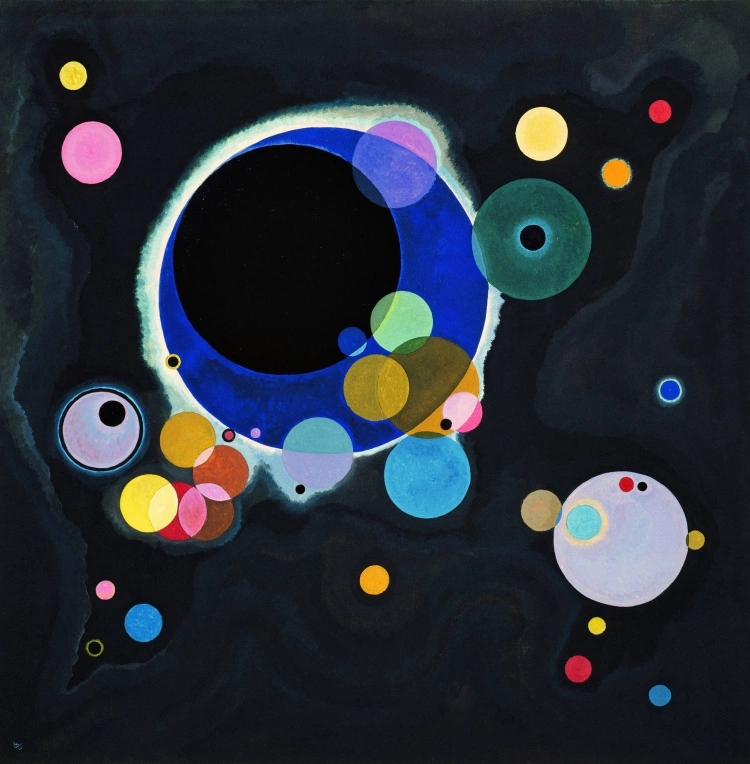
He begins by considering art as a spiritual antidote to the values of materialism and introduces the conception of ‘’stimmung’’, an almost untranslatable concept, best explained as the essential spirit of nature. He considers that in great art, the spectator, as a viewer, or a witness, does feel a corresponding thrill in himself.
Such harmony or even contrast of emotion cannot be superficial or worthless; stimmung of a picture can purify the spectator. Such works of art at least preserve the soul of coarseness, they ‘’key it up’’ to a certain height, as a tuning-key the strings of a musical instrument.
Regarding the tendency of the general public to reduce art to technique and skill, Kandinsky argues that its true purpose is entirely different and adds to art history one of the most beautiful definitions of art:
“In each picture is a whole lifetime imprisoned, a whole lifetime of fears, doubts, hopes, and joys. Whether is this lifetime tending? What is the message of the competent artist? … To harmonize the whole is the task of art’’

Kandinsky admonishes, the conception of l’art pour l’art– art for art’s sake, produces a neglect of inner meanings, a lament perhaps even more sad and ominous in our age of permanent commodification of art as a thing to transact around- to own, to purchase, to display, rather than an experience to have.
The spiritual life to which art belongs and of which she is one of the mightiest elements, is a complicated but definite and easily definable movement upwards and forwards. That movement is the movement of experience, it may take different forms, but it holds at bottom to the same inner thought and purpose.
As an explanation, Kandinsky offers a visual metaphor for the spiritual experience and how it relates to the conception of genius:
‘’The life of the spirit may be fairly represented in diagram as a large acute-angled triangle divided horizontally into unequal parts with the narrowest segment uppermost. The lower the segment the greater it is in breadth, depth, and area.
The whole triangle is moving slowly, almost invisibly forwards and upwards. Where the apex was today the second segment is tomorrow; what today can be understood only by the apex and to the rest of the triangle is an incomprehensible gibberish, forms tomorrow the true thought and feeling of the second segment.
At the apex of the top segment, only one man often stands. His joyful vision cloaks a vast sorrow. Even those who are nearest to him in sympathy do not understand him. Angrily they abuse him as charlatan or madman.
(—)In every segment of the triangle are artists. Each one of them who can see beyond the limits of his segment is a prophet to those about him, and helps the advance of the obstinate whole.
But those who are blind, or those who retard the movement of the triangle for baser reasons, are fully understood by their fellows and acclaimed for their genius. The greater the segment, so the greater the number who understand the words of the artist…’’
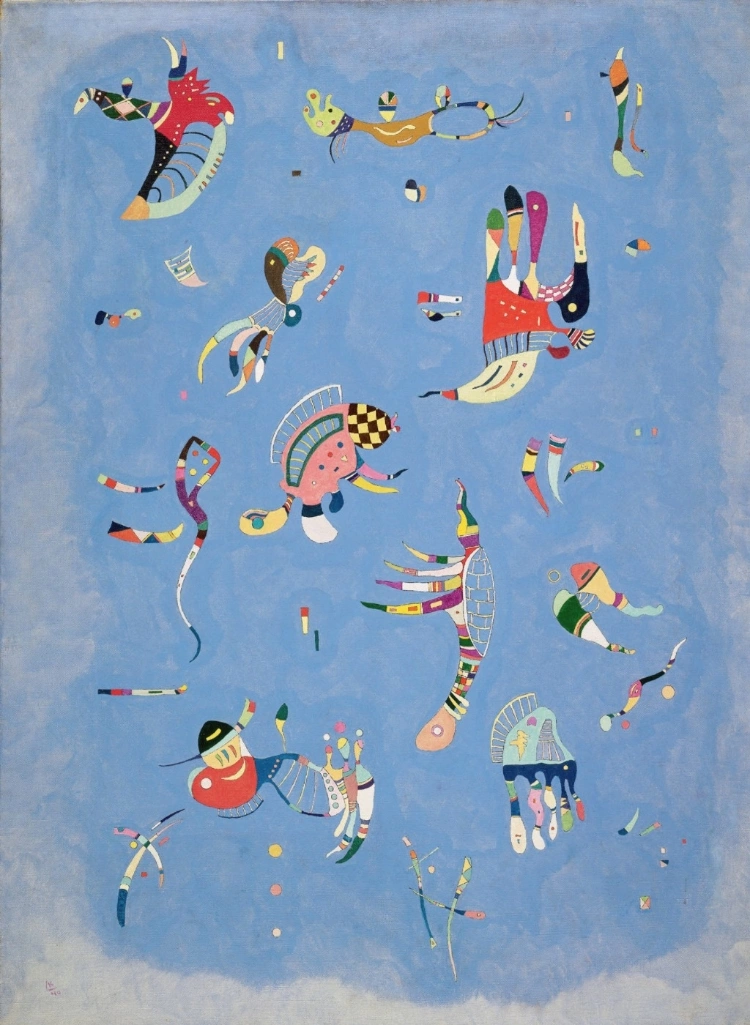
For Kandinsky, art is a kind of spiritual anchor when all other certitudes of life are unhinged by social and cultural upheaval:
“When religion, science and morality are shaken … and when the outer supports threaten to fall, man turns his gaze from externals in on to himself. Literature, music and art are the first and most sensitive spheres in which this spiritual revolution makes itself felt.
They reflect the dark picture of the present time and show the importance of what at first was only a little point of light noticed by few and for the great majority non-existent. Perhaps they even grow dark in their turn, but on the other hand, they turn away from the soulless life of the present towards those substances and ideas which give free scope to the non-material strivings of the soul.’’
But, despite this eternal spiritual element, Kandinsky recognizes that all art is inescapably a product of its time. Examining the music of Wagner, Debussy, and Schoenberg, each celebrated as a genius in his own right, he wrote that “the various arts of today learn from each other and often resemble each other… The greatest freedom of all, the freedom of an unfettered art, can never be absolute.
Every age achieves a certain measure of this freedom, but beyond the boundaries of its freedom the mightiest genius can never go. But the measure of freedom of each age must be constantly enlarged’’ and he also adds that the cross-pollination of the different arts can inform and inspire one another… “The arts are encroaching one upon another, and from a proper use of this encroachment will rise the art that is truly monumental.
Every man who steeps himself in the spiritual possibilities of his art is a valuable helper in the building of the spiritual pyramid which will some day reach to heaven.’’
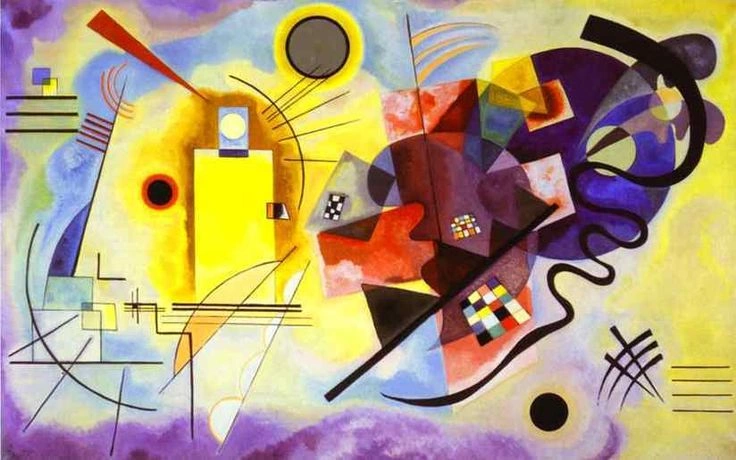
Wassily Kandinsky was synesthetic, greatly influenced by Goethe’s theory of the emotional effect of color. He considers the powerful psychic effect of color in the cohesive spiritual experience of art: “Many colors have been described as rough or sticky, others as smooth and uniform, so that one feels inclined to stroke them (e.g., dark ultramarine, chromic oxide green, and rose madder).
Equally the distinction between warm and cold colors belongs to this connection. Some colors appear soft (rose madder), others hard (cobalt green, blue-green oxide), so that even fresh from the tube they seem to be dry.
The expression “scented colors” is frequently met with. And finally the sound of colors is so definite that it would be hard to find anyone who would try to express bright yellow in the bass notes, or dark lake in the treble…Color is a power which directly influences the soul.
Color is the keyboard, the eyes are the hammers, the soul is the piano with many strings. The artist is the hand which plays, touching one key or another, to cause vibrations in the soul.’’
Considering the color and the form, and defining form as ‘’the outward expression of inner meaning”, Kandinsky examines their interplay in creating a spiritual effect: “This essential connection between color and form brings us to the question of the influences of form on color.
Form alone, even though totally abstract and geometrical, has a power of inner suggestion. A triangle (without the accessory consideration of its being acute — or obtuse — angled or equilateral) has a spiritual value of its own.
In connection with other forms, this value may be somewhat modified, but remains in quality the same. The case is similar with a circle, a square, or any conceivable geometrical figure, a subjective substance in an objective shell-The mutual influence of form and color now becomes clear.
A yellow triangle, a blue circle, a green square, or a green triangle, a yellow circle, a blue square—all these are different and have different spiritual values.’’
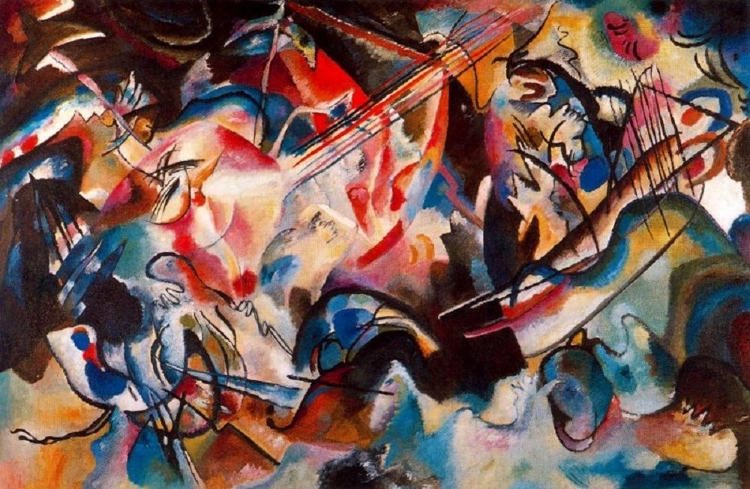
Considering the inherent aesthetic intelligence of nature, he returns to his piano metaphor: “Every object has its own life and therefore its own appeal; man is continually subject to these appeals. But the results are often dubbed either sub- or super-conscious.
Nature, that is to say the ever-changing surroundings of man, sets in vibration the strings of the piano (the soul) by manipulation of the keys (the various objects with their several appeals)’’
There is no ‘’must’’ in art, because it springs from an inner need – the psychological trifecta built up of three mystical elements:
- Every artist, as a creator, has something in him which calls for expression( the element of personality)
- Every artist, as child of his age, is impelled to express the spirit of his age( the element of style), dictated by the period and nationality to which the artist belongs
- Every artist, as a servant of art has to help the cause of art( the element of pure artistry); it is constant in all ages and among all nationality
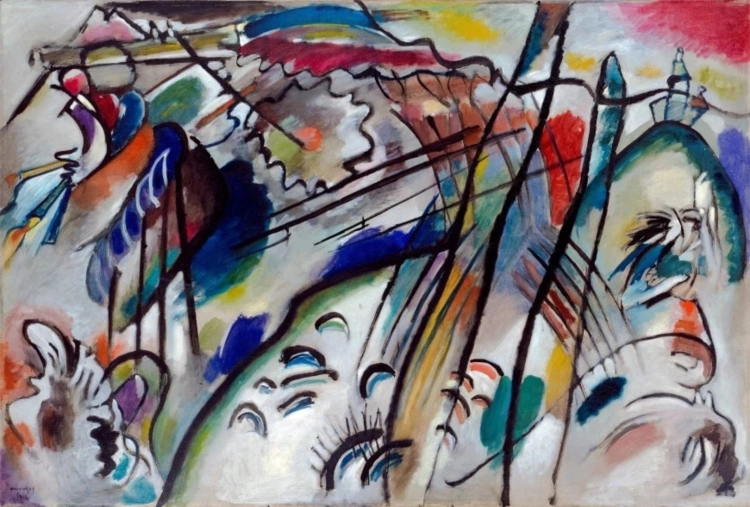
Sharing in Schopenhauer’s skepticism about style, Kandinsky predicts that only the third element “which knows neither period nor nationality’’, accounts for the timeless in art:
“In the past and even today much talk is heard of “personality” in art. Talk of the coming “style” becomes more frequent daily. But for all their importance today, these questions will have disappeared after a few hundred or thousand years.
Only the third element ( pure artistry) will remain forever. An Egyptian carving speaks to us today more subtly than it did to its chronological contemporaries; for they judged it with the hampering knowledge of period and personality.
But we can judge purely as an expression of the eternal artistry.
Similarly — the greater the part played in a modern work of art by the two elements of style and personality, the better will it be appreciated by people today; but a modern work of art which is full of the third element, will fail to reach the contemporary soul.
For many centuries have to pass away before the third element can be received with understanding. But the artist in whose work this third element predominates is the really great artist.’’
Furthermore, Kandinsky points out, the true artist gives credence only to that inner need, and not to the expectation and conventions of the time. “The artist must be blind to distinctions between “recognized” or “unrecognized” conventions of form, deaf to the transitory teaching and demands of his particular age.
He must watch only the trend of the inner need, and hearken to its words alone. Then he will with safety employ means both sanctioned and forbidden by his contemporaries.’’
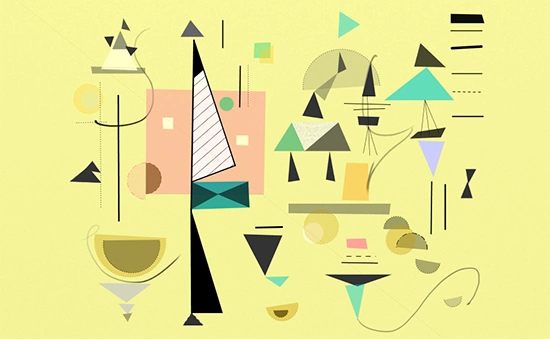
This is the reason why theory invariably fails to capture the essential impulse in art, and he offers a beautiful disclaimer of his own theoretical treatise: “It is impossible to theorize about this ideal of art.
In real art theory does not precede practice, but follows her. Everything is, at first, a matter of feeling. Any theoretical scheme will be lacking in the essential of creation — the inner desire for expression — which cannot be determined.
Neither the quality of the inner need, nor its subjective form, can be measured nor weighed.’’
He also considers the paradox of what we refer to us as ‘’beauty’’, which is more of a theoretical agreement based on convention, rather than a true spiritual response ‘’ “Outer need” … never goes beyond conventional limits, nor produces other than conventional beauty.
The “inner need” knows no such limits, and often produces results conventionally considered “ugly.” But “ugly” itself is a conventional term, and only means “spiritually unsympathetic,” being applied to some expression of an inner need, either outgrown or not yet attained.
But everything which adequately expresses the inner need is beautiful…which is produced by the inner need, which springs from the soul’’.

Reflecting on the birthplace of art, Kandinsky return to the conception of a creative freedom: “The work of art is born of the artist in a mysterious and secret way. From him it gains life and being.
Nor is its existence casual and inconsequent, but it has a definite and purposeful strength, alike in its material and spiritual life. It exists and has power to create spiritual atmosphere; and from this inner standpoint one judges whether it is a good work of art or a bad one.
If its “form” is bad it means that the form is too feeble in meaning to call forth corresponding vibrations of the soul… The artist is not only justified in using, but it is his duty to use only those forms which fulfill his own need… Such spiritual freedom is as necessary in art as it is in life.’’
Eventually, he brings everything full-circle to the metaphor of the spiritual triangle, reexamining the essence of art and the core responsibility of the artist:
‘’Art is not vague production, transitory and isolated, but a power which must be directed to the improvement and refinement of the human soul …If art refrains from doing this work, a chasm remains unbridged, for no other power can take the place of art in this activity.
And at times when the human soul is gaining greater strength, art will also grow in power, for the two are inextricably connected and complementary one to the other. Conversely, at those times when the soul tends to be choked by material disbelief, art becomes purposeless and talk is heard that art exists for art’s sake alone…
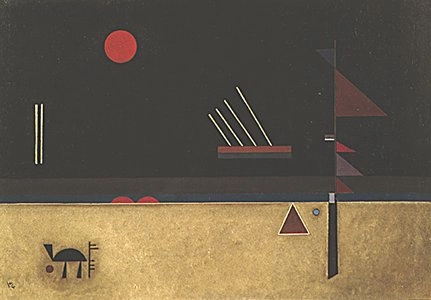
It is very important for the artist to gauge his position aright, to realize that he has a duty to his art and to himself, that he is not king of the castle but rather a servant of a nobler purpose.
He must search deeply into his own soul, develop and tend it, so that his art has something to clothe, and does not remain a glove without a hand. The artist must have something to say, for mastery over form is not his goal but rather the adapting of form to its inner meaning.
(…) The artist is not born to a life of pleasure. He must not live idle; he has a hard work to perform, and one which often proves a cross to be borne. He must realize that his every deed, feeling, and thought are raw but sure material from which his work is to arise, that he is free in art but not in life’’.
More On Kandinsky:

About David Fox
David Fox is an artist who created davidcharlesfox.com to talk about art and creativity. He loves to write, paint, and take pictures. David is also a big fan of spending time with his family and friends.
Leave a Reply
 |
 |
 |
 |
Just Art and Fun
Now get FREE Gifts. Or latest Free phones here.
Disable Ad block to reveal all the secrets. Once done, hit a button below
 |
 |
 |
 |